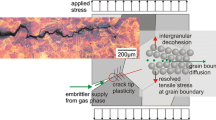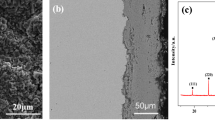Abstract
The mechanical disintegration of molybdenum disilicide in air or oxygen at temperatures of 300° to 600°C, known in the literature as “pest”, is ascribed here to stress enhanced oxidation at the tips of Griffith flaws, eventually leading to brittle fracture. Stress-free single crystals of molybdenum disilicide, which are not ordinarily subject to pest, were shown to exhibit delayed failure in four-point bend tests under the conditions that lead to pest in polycrystals. The delayed failure times showed the same temperature and oxygen pressure dependence as the times to onset of pest disintegration in polycrystals. Pest in polycrystals occurs even in the absence of an applied stress, due to the high residual stresses which are introduced upon cooling this highly anisotropic material from the melt during fabrication. Nonetheless, the superposition of an applied stress, over and above the residual stress, was shown to decrease the time to pest failure compared to unstressed specimens. The absence of pest above 600°C, and the longer times required for pest disintegration as temperature is increased above about 500°C, is explained by the presence of plastic deformation in the matrix, which tends to reduce stress concentration at the tips of flaws and to counteract the flaw sharpening effect of stress enhanced oxidation. Slip was readily observed at 600°C. The delayed failure results were consistent with the general Charles-Hillig model for the mechanical failure of brittle materials that react chemically with their environment.
Similar content being viewed by others
References
E. Fitzer:Plansee Proc. 2nd Seminar, Reutte/Tyrol, 1955, Pergamon Press, London, 1956.
R. W. Bartlett,et al.: ASD-TDR-63-753, June, 1963.
O. Burisch:Ber. Deut. Keram. Ges., 1964, vol. 41, p. 120.
J. B. Berkowitz-Mattuck, P. E. Blackburn, and E. J. Felten:Trans. TMS-AIME, 1965, vol. 233, p. 1093.
J. J. Rausch and C. R. Simcoe: Armour Research Foundation, Chicago, Ill., ARF 2981-4 (Final Report), August 31, 1961.
R. J. Charles:J. Appl. Phys., 1958, vol. 29, pp. 1549, 1554.
W. B. Hillig and R. J. Charles:High Strength Materials, V. F. Zackay, ed., J. Wiley & Sons, New York, 1965.
J. B. Berkowitz, M. Rossetti, and D. W. Lee: Final Report to NASA on Contract NASW-1403, August, 1968.
R. J. Charles: Conference on Fracture, April 12–14, 1959, National Academy of Sciences.
M. Simnad and A. Spilners:AIME Trans., 1955, vol. 203, p. 1011.
E. Gulbransen and W. S. Wysong:AIME Trans., 1948, vol. 175, p. 628.
W. W. Pultz and W. Hertl:J. Am. Ceram. Soc., 1967, vol. 50, p. 202.
E. L. Williams:J. Am. Ceram. Soc., 1965, vol. 48, p. 190.
F. J. Norton:Nature, 1961, vol. 191, p. 701.
R. M. Barrer:Diffusion In and Through Solids, p. 126, Cambridge University Press, New York, 1952.
B. E. Deal and A. S. Grove:J. Appl. Phys., 1965, vol. 36, p. 3770.
Author information
Authors and Affiliations
Rights and permissions
About this article
Cite this article
Berkowitz-Mattuck, J.B., Rossetti, M. & Lee, D.W. Enhanced oxidation of molybdenum disilicide under tensile stress: Relation to pest mechanisms. Metall Trans 1, 479–483 (1970). https://doi.org/10.1007/BF02811558
Received:
Issue Date:
DOI: https://doi.org/10.1007/BF02811558




